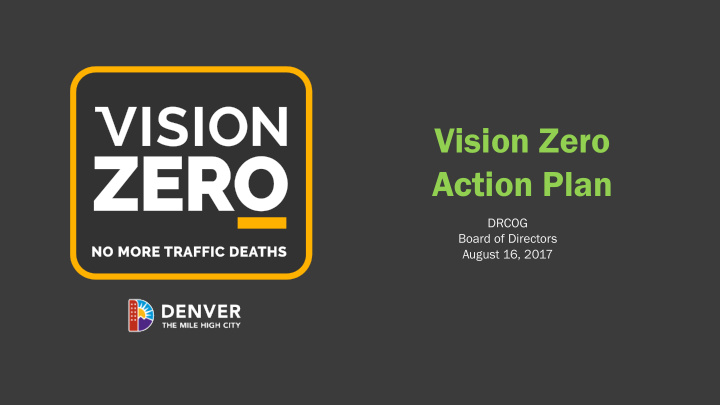



Vision Zero Action Plan DRCOG Board of Directors August 16, 2017
Vision Zero Eliminate traffic fatalities through a data- driven, transparent, and multi-agency approach. Recognize that people will make mistakes and build a transportation system that minimizes the consequences of human error. Focus on equity.
Data Analysis Key Findings Why is Vision Zero Needed? Deaths are unacceptable and • preventable. In Colorado, motor vehicle • crashes account for more than twice the number of deaths as homicides. Traffic deaths have risen over • time, and our crash rate is much higher than most of our peer cities.
Issues to Address Behaviors: Seatbelts were not used in nearly one-third of motor vehicle fatalities • In over half of motorcyclist fatalities, the rider was not wearing a helmet • Other behaviors such as failure to yield, careless/reckless driving, • impairment, hit and runs Context: Most fatal crashes occurred at mid-block locations • The majority of pedestrian and bicyclist fatalities occurred in unlit • conditions 50% of fatalities on 5% of street network •
How We Got Here Dat ata a An Anal alysis is & & Best P Prac actic ice R Revie iew Partner D Pa Discu cussions -Intensive data analysis Publi lic S Surve veys -Working Group meetings: -Similar Vision Zero -Online Map Plans Speed & Street Design -Intercept surveys -Proven countermeasures Impairment Thousands r reache hed Safety Culture -City policies -Stakeholder meetings
Intercept Surveys April 2017 • 4 locations, nearly • 200 responses Biggest concerns: • speeding, distracted driving, and crossing times Top wish for City • action: build safe streets for everyone
Map-based Survey >2800 responses • Biggest concerns: • speeding, failure to yield, and other Most people • responded as: pedestrian taking work commute trips
Map-based Survey
Action Plan Timeline February – April: TAC Working Group meetings 5/31: TAC draft recommendations 6/14: Comments due from TAC members 6/29: Core Group meeting to review draft Action Plan 7/19: TAC meeting: draft Action Plan 7/ 7/20 20: draft Act ction Pl Plan open en for public com commen ent 8/11: draft Action Plan closes for public comment 9/7 : TAC meeting: final Action Plan
Action Plan Components Front Matter • Mayor’s commitment, remembrances • Our Call to Action • Let’s Take Action • Strategies, actions, benchmarks • Positive Changes • Recent projects, relevant history • How We Developed the Plan • How to be Part of Vision Zero •
Data Analysis Key Findings Our Call to Action This is a five ve-year ear Action Plan for eliminating traffic deaths by 2030 030. Someone loses their life every six days while traveling in our city. We do not have to accept this as inevitable.
Denver’s Needs 1. Enhance Processes and Collaboration 2. Build Safe Streets for Everyone 3. Create Safe Speeds 4. Promote a Culture of Safety 5. Improve Data and Be Transparent
An Equitable Plan • Avoiding actions that have unintended consequences • Prioritizing efforts towards Communities of Concern • Choosing the right benchmarks
Data Analysis Key Findings Focus Areas Focusing efforts on the most dangerous streets and in the most vulnerable communities is a responsible use of limited City resources.
High igh Injur Injury Netwo work All Modes 123 miles • Around 5% of • Denver’s street network Approximately • 50% of fatalities occurred on HIN
Com ommunities of C of Con oncern (CoC) 30% of Denver but 38% all traffic deaths and 44% of pedestrian deaths
Data Analysis Key Findings What We’re Doing 30 th Avenue & Downing Street: RRFB
Data Analysis Key Findings What We’re Doing Morrison Road: medians and bump-outs
Data Analysis Key Findings What We’re Doing 13 th Avenue & Broadway: left turn arrow and LPI
Data Analysis Key Findings What We’re Doing 5 th Avenue & Lincoln Street: temporary treatments
Rach chael Bron onson Rachael.bronson@denvergov.or org 720-865-2658
Recommend
More recommend